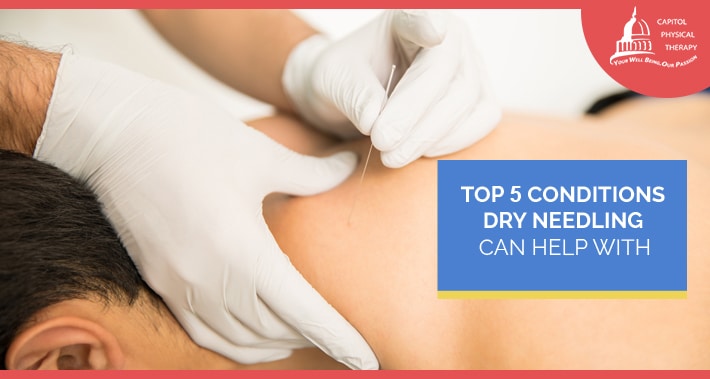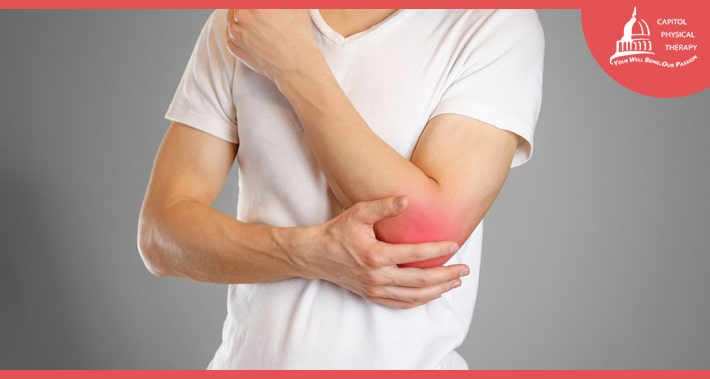
Are you dealing with chronic pain?
Do you have fibromyalgia, carpal tunnel syndrome, or another chronic pain condition?
Are you looking for a minimally invasive alternative to traditional pain medications?
If so, physical therapy involving dry needling might be for you.
Dry needling is one of the techniques physical therapists use for pain management and relief.
Dry needling is an effective solution for pain, tension, and dysfunction in your muscles.
Additionally, dry needling can help speed up the rehabilitation process after injury or trauma.
If you’re interested in learning more about how dry needling therapy can help with a variety of conditions, you’ve come to the right place.
In this article, we’ll take a closer look at dry needling, as well as some of the most common conditions that it can help with.
Keep reading to learn more.
How Does Dry Needling Work?
Dry needling is also known as “trigger point needle therapy” or “myofascial trigger point dry needling.”
Dry needling is a physical therapy technique used at our physical therapy clinics to help treat muscle pain associated with a wide variety of conditions.
It requires specialized training, so only certified physical therapists, like Dr. Subha Nagasubramanian and Maya Drummond can provide this treatment.
There are 3 different types of dry needling:
- Trigger point drug needling
- Non trigger point dry needling
- In and out dry needling
The trigger point dry needling process includes inserting a type of thin needle known as a filiform needle into areas of your muscles where you feel the greatest discomfort.
These areas are referred to as “trigger points”.
Trigger points are areas where the muscles are knotted or hardened and remain there for a short period of time.
By inserting the needles it releases acetylcholine, a neurotransmitter that tells your muscles to contract, from your trigger points.
This subsequently improves pain, range of motion limitations, and function.
Filiform needles don’t contain any medicine and therefore don’t inject any substance into your body.
This is why it’s called dry needling, to distinguish it from “wet needling”, which is when hypodermic needles used to inject medicine or draw blood work are used.
Dry needling, like acupuncture, helps with pain.
But dry needling also differs from acupuncture.
If you’ve ever had acupuncture done before, the needles used are the same, though the reason for doing the treatment and the technique is different.
With trigger point dry needling your physical therapist inserts the filiform needle directly onto the muscles where you are feeling the greatest pain or discomfort.
This often generates an involuntary muscle twitch as the acetylcholine messenger releases.
This allows the treatment to work as the muscle can then relax to its normal tone.
In non trigger point dry needling, the filiform needles are placed near your pain points but not on them.
In and out dry needling involves pushing the needle in and pulling it out.
Your physical therapist moves the needle from deeper to shallower tissues, without removing it, in a technique called pistoning.
Benefits of Dry Needling
Dry needling can be used to provide treatment for a number of ailments.
Below, we’ve highlighted some of the most common conditions that can benefit from dry needling.
1. Nonsurgical Carpal Tunnel Syndrome Treatment
Carpal tunnel syndrome is a condition caused by excess pressure on the median nerve located in your hand.
It is a type of repetitive strain injury that can benefit from dry needling.
Studies on repetitive strain injuries show that these injuries can happen in almost any area of the body.
This pressure frequently results in numbness, weakness, and pain throughout your hand and wrists.
However, dry needling can be an effective nonsurgical carpal tunnel syndrome treatment.
If you are struggling with carpal tunnel syndrome, you may also have compressed nerves within your arm, shoulder, and neck.
By relieving the pressure off these trigger points, dry needling can help with pain in the neck and pain in the shoulders associated with carpal tunnel syndrome.
It’s also a good idea to consider an ergonomics consultant for your workspace, if your carpal tunnel syndrome is related to a workplace injury.
2. Natural Pain Relief Treatment
Dry needling is an effective natural pain relief treatment for pain associated with a variety of conditions, including:
- Chronic headaches and migraines.
- Spinal issues
- Night cramps
- Degenerative disc disease
- Jaw and mouth issues
- Sciatica pain
- Lower back pain
- Hyperlordosis
- Upper back pain
- Bursitis in your hips
- Mysofasical pain syndrome
- Bone spurs
- Herniated discs
- Kyphosis
When your muscles are injured or overused, they can become too contracted and prevent normal blood flow to the surrounding areas, making it difficult for healing to occur.
Subsequently, the nerve becomes sensitive and painful.
Your physical therapist can use dry needling to help correct your blood flow and flush out the area near the trigger point.
Some people experience pain relief after their first dry needling session, whereas others will need multiple treatments to experience full benefits.

3. Tennis Elbow
Tennis elbow is a condition commonly associated with sports injuries.
But, you don’t have to be a tennis player to get tennis elbow, just like you don’t need to be a runner to get runner’s knee.
In fact, you can get tennis elbow through working at a desk, playing a musical instrument or any number of other repetitive movements.
It can also occur due to lifting substantial weight.
It’s as much an issue of ergonomics as it is athletics.
It occurs due to the overuse of the extensor muscles in your forearm.
Tennis elbow impacts your tendons that attach to your elbow bones and help with grip and throwing.
However you happen to get tennis elbow, dry needling can be an effective tennis elbow physical therapy or sports injury physical therapy treatment.
A 2017 study looked at 110 patients with lateral epicondylitis, which is the scientific name for tennis elbow.
They split them into two groups.
The first group received dry needling, and the second received the standard tennis elbow treatment of a forearm brace and ibuprofen.
After six months, the study found that while both options helped, the dry needling was significantly more effective.
The study does admit that more research needs to be done, but these initial results are promising.
4. Knee Arthritis Pain
Osteoarthristis is a condition that causes joint swelling and inflammation.
It occurs most commonly in seniors.
RELATED: Physical Therapy for Seniors Health Issues
Research points to dry needling as an effective treatment for pain in the knee associated with osteoarthritis.
Dry needling helps to relieve chronic pain naturally and restore functionality in the knee.
However, it can’t stop the degeneration associated with arthritis.
The bone locking mechanism that allows you to stand with minimal effort without knee buckling is often affected in arthritis resulting in overuse of your quads.
Dry needling your quads, when appropriate, can help reduce referred pain to the knee from overworking muscles.
Further, knee range of motion is often limited due to osteoarthritis and dry needling may be able to increase range of motion in cases where motion is limited by the soft tissues.
Additionally, reducing your pain and improving range of motion will make it easier for you to participate in physical therapy.
It can help you do the activities you enjoy for longer, which can further decrease your arthritis symptoms.
RELATED: Frequently Asked Questions About Arthritis
5. Natural Fibromyalgia Relief
Fibromyalgia is a chronic condition which may cause:
- Muscle pain
- Tenderness throughout the body
- Chronic fatigue
- Cognitive issues
- Mental health issues
- Dry eyes
- Headaches
- Insomnia
- Stomach issues
Individuals with fibromyalgia often develop trigger points.
Because it’s a relatively new diagnosis, fibromyalgia is not as well understood as some other pain related disorders.
Fibromyalgia is also difficult to diagnosis because it symptoms can resemble other chronic pain conditions, such as rheumatoid arthritis and multiple sclerosis.
Studies show that dry needling can be effective as a form of natural fibromyalgia relief.
Dry needling can help to relieve the pressure from trigger points associated with fibromyalgia.
It also helps release endorphins, a natural biochemical that has similar effects to traditional pain medications, such as opioids.
By releasing these endorphins, dry needling helps your body release pain and improve fibromyalgia symptoms.
Book Your Appointment With Capitol Physical Therapy Today
If you would like to learn more about the many benefits of dry needling, don’t hesitate to reach out.
At Capitol Physical Therapy, our expert staff has a special interest in helping you relieve your pain through minimally invasive methods.
Book your appointment with Capitol Physical Therapy today.
1331 H St NW #200,
Washington, DC 20005
- https://g.page/capitolptdc
9560 Pennsylvania Ave. # 202,
Upper Marlboro, MD 20772
- https://goo.gl/maps/zjL4NnnuThRhrcS86
Capitol Physical Therapy offers orthopedic and other pain related solutions, with our versitile team of physical therapists in Washington, DC